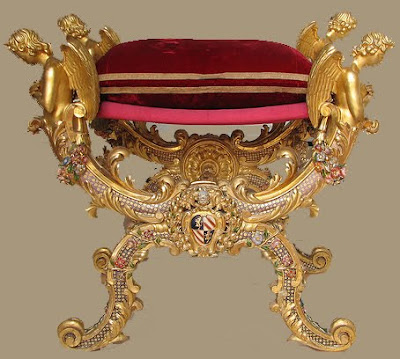By now you know that my favorite antique terms are those designed to confuse, obfuscate, and otherwise drive normal people crazy.
That's why I like the word "curule" so much. First, it's weird to pronounce: "Q rule." Second, it's defined as "the same thing as a faldstool and the same thing as a ployant." Well, that's just great and thanks for nothing. Antiquarians can be a cruel lot.
So let's get real here: a curule, a faldstool, and a ployant are all words for a portable stool that usually (but not always) folds up and has X-shaped legs with no back. Here's a nice Louis XIV curule:
And for those of you who prefer that their feet actually reach the floor, I have this French Empire pair:And here's a 19th century English cast brass one:
Some people say that faldstools are used most commonly when referring to ecclesiastical curules. Years ago, that was true but nowadays that's pure baloney. In fact, people in the trade frequently say faldstool for ANY folding stool.
What's not baloney is that curules, faldstools and ployants can be very simple or extremely ornate. Take a gander at all of these (some modern, some reproductions and some antiques):
But what about curules, etc. at C. Mariani Antiques (where I work)? I wouldn't be true to this blog if I didn't put in a plug for myself. After all, I'm nothing if not self-serving. Here's a fab pair of palazzo scaled 19th c. Italian ployants (they measure 25 1/2"h x 30"w x 24" d-so when I sit on them my feet dangle 3" off the ground):
Call me for details-415 541 7868.
















.jpg)




















